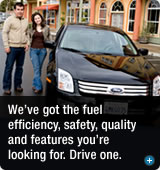Selecting Insurance Coverage
Learning about the differences between insurance coverage types will help you choose coverage appropriate to your needs.
The information below is for reference only. You should consider consulting a licensed insurance agent before making your insurance decisions.
Insurance Coverage Types
The three main types of coverage to consider when choosing insurance include liability, collision and comprehensive.
You may also encounter other types of insurance coverage like Personal Injury Protection (PIP), Uninsured and Underinsured Drivers and Guaranteed Auto Protection (GAP) insurance. Some states may require you to purchase some, but not all, of these components.
Liability
Liability insurance offers you protection if you are deemed at fault for an accident. Liability insurance could provide you coverage for damage to another person's vehicle, as well as the injured party's medical expenses, suffering and lost income.
Drivers in every state are required to carry liability insurance. Minimum coverage amounts vary from state to state.
Collision
Collision insurance may cover vehicle replacement (if the vehicle is totaled) and repairs from impact with another vehicle, person or object. This type of insurance covers damage regardless of who is at fault.
States do not require that you purchase collision coverage.
Comprehensive
Comprehensive insurance may include vehicle replacement, in case the vehicle is totaled, and repairs if your vehicle is stolen or damaged by fire, vandalism, hail, flood or high winds.
This type of coverage may also include reimbursement if your windshield cracks or shatters.
States do not require that you purchase comprehensive coverage.
Personal Injury Protection (PIP)
PIP coverage may pay for accident-related medical expenses. PIP becomes significant only if you are deemed at fault for an accident. If the other driver is at fault, the other driver's insurance will cover costs.
Regular health insurance may provide protection for some accident-related medical costs, but it may not cover injuries to non-family passengers. PIP usually provides coverage for specified maximum amounts.
Not all states require this type of coverage, especially if you live in a state with no-fault insurance. Check with an automotive information third-party source to determine whether Personal Injury Protection (PIP) is optional in your state.
Uninsured and Underinsured Drivers
Unfortunately, everyone must bear the cost of those who drive without insurance. Uninsured and underinsured driver's coverage may protect you if the other driver involved in your accident has insufficient insurance to pay for your losses. It will also offer protection if you are injured as a pedestrian.
This coverage is not required by every state.
Guaranteed Auto Protection (GAP) Insurance
This type of coverage is necessary only if you are leasing a vehicle. If your leased vehicle is stolen or totaled, GAP insurance may cover the difference between the replacement cost paid by the insurance company and the amount owed to the leasing company under the terms of your lease.
While not required by states, many leasing companies require this type of coverage.
Endorsements
Through endorsements (sometimes called "riders") to an insurance policy, you may obtain additional coverage to expand your coverage to cover things such as vehicle rental, cracked windshields or emergency towing costs.
Lowering Monthly Premiums
The Insurance Information Institute, an association that tries to improve public understanding of insurance, recommends the following tips to help you pay less for your vehicle insurance.
Consider Higher Deductibles
Deductibles represent the amount of money you pay before you make a claim. By requesting higher deductibles on collision and comprehensive coverage, you may be able to lower your premium substantially. However, when raising your deductible, you should consider how much you'd be able to afford in the event of an accident.
Take Advantage of Low-mileage Discounts
Some companies offer discounts to motorists who drive fewer than a predetermined number of miles a year.
Check for Safety Features
Purchasing a vehicle with a high safety rating or having anti-lock braking systems, airbags and other features on your vehicle may help lower premiums.
Invest in Anti-theft Devices
Tell your insurance company about any alarm systems, hidden tracking devices and other anti-theft devices installed in your vehicle. They may garner up to a 15 percent discount on your comprehensive coverage.
Show Your Insurance Company Loyalty
Your insurer may offer a 10 to 15 percent discount if they provide you with both homeowner and auto insurance policies.
Inquire About Education and Driving-related Discounts
Check with your insurance carrier for these common driving-related discounts:
- Safe Driver Discount—No moving violations or accidents in the past three years may reduce your premiums as much as 40 percent.
- Good Student Discount—Good grades could garner savings.
- Defensive Driving for Seniors—By taking a defensive driving course, seniors (especially those over 70 years old) may cut premiums by 5 to 10 percent.
- Driver's Education Discount—Some insurance companies may give you a discount for taking a driver's education course.

